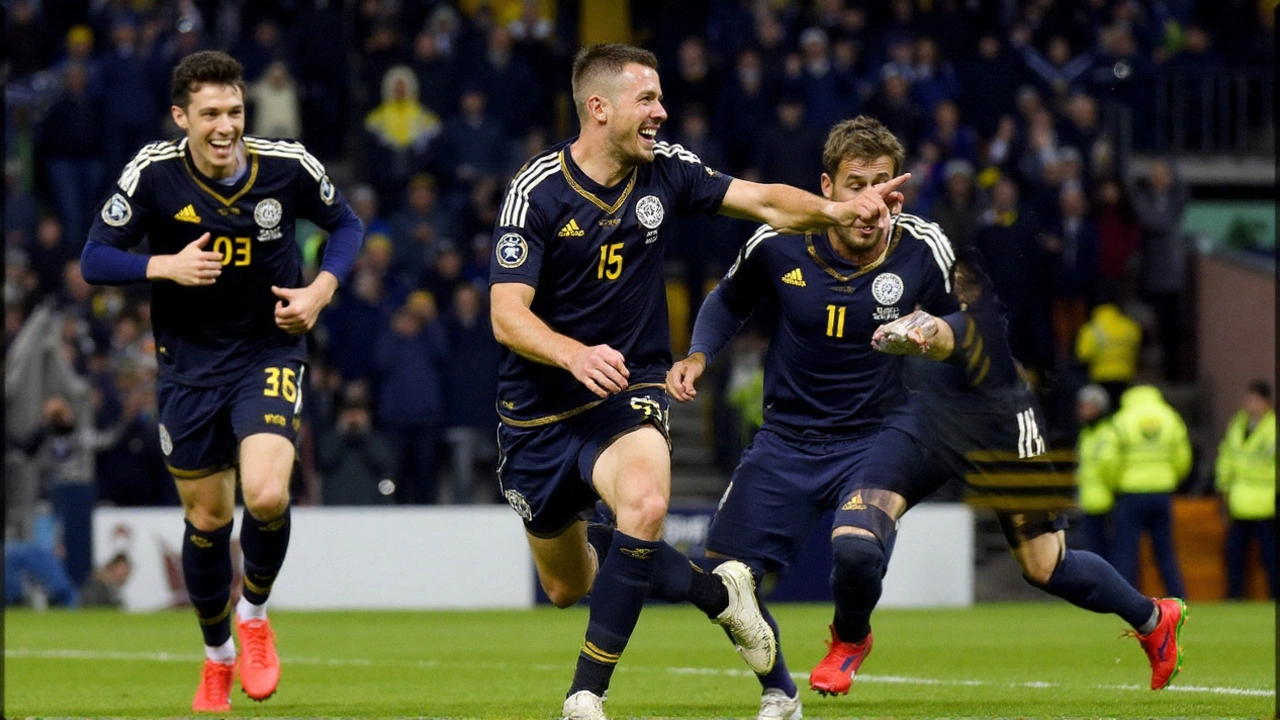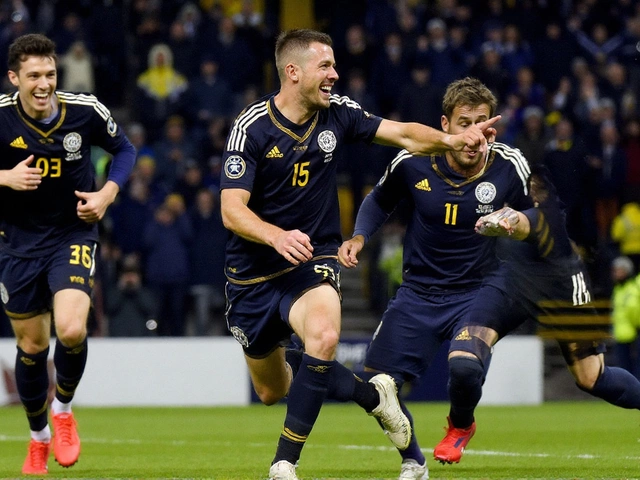Stakes high, margins thin: Scotland’s must-take chance against Belarus
This is the type of qualifier that defines a campaign. After a goalless draw with Denmark, Scotland walk into ZTE-Aréna needing a first win to keep pace at the top of Group C. Belarus arrive from a bruising 5-1 defeat to Greece and still sit on zero points, which makes this meeting more dangerous than it looks on paper. A desperate opponent can be the hardest to handle.
There’s another wrinkle: the venue. Belarus are hosting at ZTE-Aréna in Zalaegerszeg, Hungary, rather than Minsk. A neutral ground levels out the usual home-field advantages—travel routines, familiar turf, and crowd energy. Expect a split crowd and a flatter start than a typical home tie, which often favors the better-organized side.
For Scotland, the mission is simple: turn control into goals. Under Steve Clarke, they’ve built a reliable structure and squeezed points from tight games. But they need punch in the final third. John McGinn’s deliveries, Scott McTominay’s late runs and aerial threat, and Che Adams’ movement between the lines are supposed to provide that spark. Adams, fresh from a June hat-trick against Liechtenstein, gives them a focal point when the build-up gets sticky.
Belarus have a different path to a result: stay compact, slow the rhythm, and wait for mistakes. Goalkeeper Lapoukhov has been a busy man in recent outings and will likely be called on again. In front of him, Pavel Zabelin anchors a defense that must reset fast after the Greece loss. Expect a back five out of possession, with full-backs dropping deep and a single runner kept high for counterattacks.
Scotland will try to control the middle. McTominay’s physical presence matters not just on set pieces but also in closing counters at the source. If Scotland win second balls around the center circle, they can keep Belarus penned in and repeatedly recycle attacks. McGinn will look to angle crosses toward Adams and the back-post runner—one of Scotland’s best patterns when the box gets crowded.
Belarus, meanwhile, need to pick their moments. If they sit too deep for too long, the pressure usually tells. Their best route is the channel ball behind an advancing wing-back, forcing Scotland’s outside center-backs into foot races facing their own goal. That’s where transitions can flip the script and give Belarus a clean look at goal.
Set pieces could decide it. Scotland under Clarke have leaned on restarts to break stubborn teams, and McTominay’s timing in the air makes him a problem to mark. Belarus can be dangerous too if they can draw fouls in wide areas and make Scotland defend the near-post crowd. With both teams managing heavy legs in a quick turnaround window, dead-ball moments are prime opportunities.
What about lineups? Scotland won’t rip up their shape after a disciplined draw with Denmark. A back three with flexible wing-backs remains the base. McGinn and McTominay are near locks in midfield. Adams should lead the line, with support either from a roaming No. 10 or an inverted winger drifting inside to combine. The bench matters here: fresh legs around 60 minutes—pace wide, a different profile up top—could be decisive if Belarus tire.
Belarus are likely to mirror with a tight defensive block and a counter-punching approach. Lapoukhov in goal, Zabelin marshalling the back line, and a midfield tasked with tracking runners rather than chasing possession. The first 20 minutes will tell us a lot: if Belarus commit numbers forward early, it means they think Scotland can be rattled. If not, it’s a long shift of discipline and waiting for a single clean break.
Team news is light on drama. Scotland had no fresh suspensions off the Denmark game and have been managing knocks rather than major absences. Expect continuity, not wholesale changes. Belarus’ staff, facing quick-turnaround fatigue after Greece, may rotate one or two spots to add legs in midfield and at wing-back, but the spine—Lapoukhov and Zabelin—should stay.
Beyond personnel, it’s about rhythm. Scotland need quicker ball speed around the box—fewer safe touches, more wall passes and third-man runs. When McGinn gets half a yard out wide, the near-post sprint and the far-post peel must happen on cue. Adams thrives when those patterns are sharp. Belarus will try to break that rhythm with tactical fouls and by pushing Scotland into low-percentage crosses from deeper angles.
Keep an eye on transitions after Scotland corners. If Belarus spring two players forward and hit the first pass cleanly, Scotland’s rest defense will be tested. That’s where McTominay’s recovery runs and the outside center-back’s positioning matter. One misread, and a tight match can flip.
The stakes are plain. Three points keep Scotland level with or ahead of Denmark, depending on other results, and inject belief into a group that still feels open. A draw turns the table math messy. For Belarus, any point is momentum, and a win blows oxygen into a campaign that has started rough.
Conditions should favor the team that manages tempo. Early September in Hungary can be warm, so pacing the press and using in-possession rest—circulating side to side before the vertical punch—will be key. Scotland have more experience at closing out these kinds of games, but experience doesn’t score by itself. They’ll need end product.
If you want a simple checklist for the night: Scotland must win the aerials on set plays, keep their wing-backs high enough to pin Belarus without getting caught behind, and get Adams touches inside the box not just in the channels. Belarus must survive the first wave, frustrate from minute 20 to 60, and make the first big transition count. Do those things, and the balance swings.
Strip away the noise, and this is what remains: a neutral venue, two teams with very different problems to solve, and a game where patience will decide who keeps their World Cup path straight. For the visitors, it’s a test of control and precision. For the hosts, it’s about resilience and timing. On nights like these, one clean delivery from McGinn or one big stop from Lapoukhov can shape a group.
Projected shapes, key battles, and what a result changes
Belarus vs Scotland should open with familiar shapes: Belarus in a 5-4-1 that can flip into a 3-4-3 on the break; Scotland in a 3-4-2-1 with license for one midfielder to burst beyond Adams. Watch these matchups:
- McTominay vs Belarus’ holding midfielder: who wins second balls dictates territory.
- McGinn’s delivery vs Belarus’ near-post defending: one lapse equals a free header.
- Adams vs the central center-back: if Adams drags him wide, space opens for late runners.
- Zabelin vs underlaps: whether Belarus’ leader can sort switches when Scotland flood the half-spaces.
Likely personnel, based on the last round and short turnaround:
- Scotland XI framework: Three center-backs; two energetic wing-backs; McTominay plus a ball-progressor in midfield; McGinn floating; Adams up top.
- Belarus XI framework: Lapoukhov; Zabelin leading a back three/five; compact midfield four; one striker ready to chase channels.
What changes with the result?
- If Scotland win: they keep pace with Denmark at the summit and bank a vital away result that buys margin for error before the next double-header.
- If it’s a draw: pressure shifts to home fixtures, and every set piece becomes even more precious.
- If Belarus win: they’re back in the conversation, and Group C tightens fast.
It may not be free-flowing. It probably won’t be easy. But if Scotland find one clean move or one set-piece header, they’ll feel they did the hard part: turn control into points. Belarus know what to do to stop that. That’s why this one matters.


